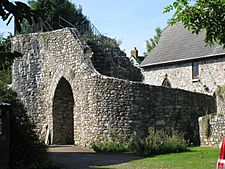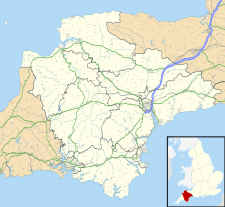Hemyock Castle facts for kids
Quick facts for kids Hemyock Castle |
|
|---|---|
| Hemyock, Devon, England | |

Ruins of Hemyock Castle
|
|
| Coordinates | 50°54′45″N 3°13′53″W / 50.91249°N 3.23144°W |
| Site information | |
| Owner | Private |
| Site history | |
| Materials | Chert stone rubble |
| Events | English Civil War |
Hemyock Castle is an old castle in the village of Hemyock, Devon, England. It was built way back in the 1300s by Sir William Asthorpe. The castle was designed in a square shape, which was popular at the time.
Even though it looked impressive, the castle wasn't very strong for defending against attacks. By the 1500s, it was already falling apart. It was used during the English Civil War in the mid-1600s, but then it was torn down. Today, you can still see parts of the old castle walls. There's also a house called Castle House, built inside the castle grounds in the 1700s.
Contents
History of Hemyock Castle
Early Days and Building the Castle
Hemyock Castle is located in the Culm valley, within the Blackdown Hills. The land where the castle stands belonged to the Hidon family a long time ago, in the 1000s and 1100s. Later, it passed to the Dynham family. In the 1200s, a building was put up on this spot. It was protected by a spring-fed moat, which is like a ditch filled with water.
Sir William Asthorpe became very wealthy when he married Margaret Dynham in 1362. This marriage made him an important person in the area. However, he was new to Devon, so his position wasn't totally secure. In November 1380, Sir William Asthorpe got special permission from the king to build a new castle. The castle would help protect him. It was also meant to show off his wealth and power to everyone.
What the Castle Looked Like
Hemyock Castle was built in a square design, which was a popular style back then. It had a rough square shape with round towers at the corners. Stone walls connected these towers. We don't know the exact layout of the whole castle.
However, we know it had a gatehouse on the east side. This gatehouse had two towers and a portcullis, which is a heavy gate that could be lowered. There were at least five other towers along the castle walls. The walls and towers were about 4.5 feet (1.4 meters) thick. They were made from chert stone rubble. The builders also used pieces of iron slag, which was leftover from metalworking in the village. The castle walls were probably painted white with lime to make them look even more impressive.
There might have been another entrance on the west side, but this isn't certain. A large mound of earth was built to the north of the castle. This might have been for defense, or to hide the castle from a nearby road. Even though the castle looked grand, it wasn't very practical. The gatehouse wasn't designed well, and the upper parts of the towers didn't have usable rooms.
The Castle in Later Years
By the early 1500s, when a historian named John Leland visited, Hemyock Castle was already in ruins. Only a few towers were still standing. By 1566, the middle part of the castle was being used to grow apples!
In 1642, the English Civil War began in England. This was a fight between King Charles I and his supporters (Royalists) and the supporters of Parliament. Lord Poulett, who supported the King, took control of the castle soon after the war started. During the war, Parliament's forces captured the castle and used it as a prison. In 1660, King Charles II was put back on the throne. After this, Hemyock Castle was torn down.
Castle House and Modern Times
Between the 1700s and 1800s, a building called Castle House was built inside the old castle walls. Parts of an older 1400s building were used, along with stones from the ruined castle walls and towers. In the late 1700s, the top parts of the castle towers were destroyed by the person renting the land.
At the end of the 1700s, a British military officer named General John Graves Simcoe bought the castle. He changed Castle House, probably around 1800, to look more like a Gothic style building.
The castle was repaired and restored starting in 1983. Castle House also had some modern updates. Today, Hemyock Castle is protected by UK law. It is considered a special historic building and a scheduled monument.


